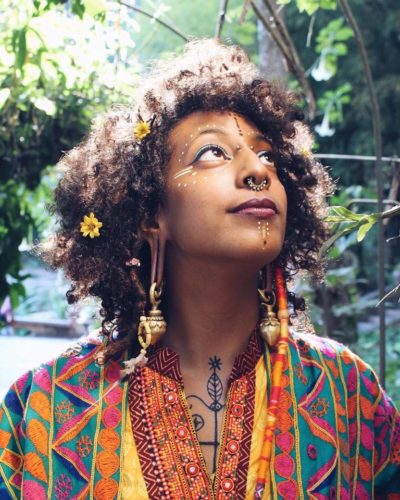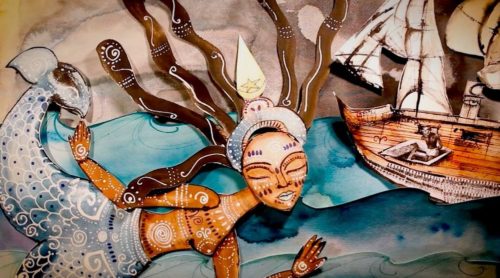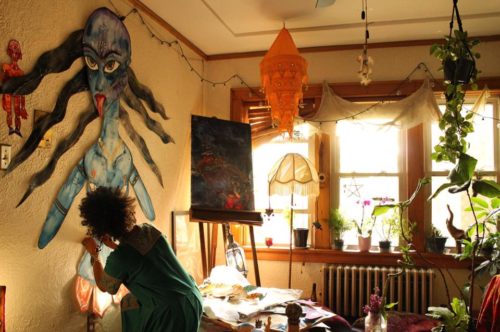CHIANG MAI, Thailand — From the early 1600s to the mid-1800s, living African slaves would sometimes be thrown overboard from slave ships sailing the Middle Passage, as the transatlantic voyage of the slave trade was called. If the slave ships faced water shortages or any kidnapped Africans came down with a disease, slaves could be tossed overboard, sometimes chained together en masse.
“So many bodies of dead or dying Africans were jettisoned into the ocean that sharks regularly followed the slave ships on their westward journey,” according to that encyclopedia entry.
In the new film The Water Will Carry Us Home by multidisciplinary artist Gabrielle Tesfaye, those ships are followed by a very different entity: Yemaya, the Yoruba orisha of the sea and the mother of all life.

Gabrielle Tesfaye [Lindsie Muller].
A first-generation American born to an Ethiopian father and mixed-heritage Jamaican mother, Tesfaye puts her multidisciplinary approach to work in The Water Will Carry Us Home. Along with depictions of slave ships and a glimpse of a newspaper ad from the 1780s announcing a slave sale, the film uses Tesfaye’s puppets of Yemaya and Papa Legba, the Haitian Vodou loa, and brings them to life via stop-motion animation. (The two deities are identified in prints for sale on Tesfaye’s website, but are not named in the film. The film, however, does mention the water spirit Omambala. Scroll to the bottom of the film page of Tesfaye’s website to view the entire work.)
The six-and-a-half-minute film opens with Tesfaye in solitary ritual at her altar, with the veve of Papa Legba inked on her chest (“He’s my guide!” she told the Wild Hunt). The hamsa, or hand of Fatima, is henna-tattooed on her palm. The film closes with Tesfaye holding a solitary ritual beside the ocean.
“Ancient African tribes such as the Dogon. . . believed that the world started from water/mer-people,” Tesfaye said. “Water also represents the vastness which the slave ships traveled across from Africa to the Americas and Caribbean. Tragedy has occurred in these waters, as the bottoms of the ocean depths are full of the bodies of our ancestors that were thrown overboard during the Atlantic slave trade. It was a history I’ve deliberately wanted to create for a while, and with much research, patience and work, I did it. This film was a huge initiation for me as an artist.”
Tesfaye grew up in Milwaukee and New York. She studied at the Fashion Institute of Technology in New York City and the Mahidol University International College in Bangkok, Thailand, before earning her bachelor’s degree in fine arts from Peck School of the Arts at the University of Wisconsin-Milwaukee. She also has been an artist in residence at the Tholpavakoothu Puppetry Theatre in Kerala, India. Her work has been exhibited in galleries and shows in London, Dublin, Chicago, New York and Thailand.
She has lived in Thailand since August, 2017. “I have a nomadic spirit and travel often, not staying in one place for too long,” she said.

The Yoruba orisha Yemaya is depicted in this scene from the film The Water Will Carry Us Home by Gabrielle Tesfaye [courtesy].
The Wild Hunt: How do you describe your spiritual path, and how did you find your way to it? Concerning The Water Will Carry Us Home, are you a devotee of Yemaya or other Yoruba orishas?
Gabrielle Tesfaye: My spirituality is free, without label. It involves pieces of many cultures, because of my multicultural background as a daughter of the Afro and Asiatic diaspora. However, I do not take on any as my one religion or consider myself a devotee to one belief system. Yoruba orishas, Vodou loa, Egyptian and Hindu gods and goddesses, and many other spirits without names all make up my limitless world.
TWH: What was your inspiration to become an artist?
GT: I was introduced to art when I was child. When we are little, we are given dolls, toys, puzzles, crayons to play with. I stuck with my paint and crayons. When I found out art is an actual career in the world, well, it was a no-brainer. It wasn’t a decision at all.
TWH: How did you come to be creating art with spiritual/visionary/mystical themes as opposed to dogs or seascapes (not that there’s anything wrong with that). Did your artistic path and spiritual path develop hand in hand, or did they fuse later? Did you feel a “calling” to be creating work with orishas, goddesses, loa, the third eye, kundalini and other spiritual subjects?
GT: As an artist, I have a strong connection to my inner world. The subjects within my art have always reflected that. For example, in high school I dealt deeply with emotional turmoil, and my paintings reflected that at the time, physically manifested as tender self-portraits. During breakups, my drawings were of heart-ached women.
When mystical interest became prevalent in my life, it naturally showed itself in my work. What is in my day-to-day life and what is in my art are one in the same. Because spirituality isn’t something that is just in my thoughts, it is also a part of my practice, and art is a sort of magick and ritual as well.
TWH: Creating is a sacred or magical act for you? That is, when creating art, do you feel you are getting in touch with the divine, or entering alternate reality, or communing with the orishas, goddesses or gods?
GT: I do treat creation as a sacred act. My painting table is full of crystals and candles, just like my altar. In addition, I channel. I didn’t realize it until I had the language to identify it. Now I am able to do it consciously. For instance, when creating the film, all of it was channeled. I created space for ancestors and spirits to safely come to me with memories, emotions, sounds, and visuals to share that moment in time. Sometimes I would receive nothing, and have to be patient for weeks of no film-making. Other nights the gates would swing open and the channels would come so fast — those were the nights I was in the animation studio for 12 hours at a time.
TWH: You truly are an interdisciplinary artist — painting, drawing, animation, film, puppetry and interactive installation. How and why did that come to be?
GT: I started with painting and drawing, but always knew I wanted to do more because I’ve always cared about exploring with new ways to engage an audience into the realm of art and all it can be. I love puppetry because it can be interactive and give viewers a different gallery experience than just looking at a still piece on a wall. I love film because it’s a new media vortex that combines visuals and movement with sound.

Artist Gabrielle Tesfaye at work in her studio on a puppet of the Hindu goddess Kali [courtesy].
GT: It wasn’t until four years ago in my past Harlem home when I discovered my love for puppetry. One night, I painted a face and decided to cut it out of the paper. Then I painted a neck and shoulders, and cut those out. I continued this for each body part, painting hands, arms, and legs, put them together and I had a giant body taking over the entire floor of our living room.
I found a way to connect them at the limbs so the parts are mobile, and that’s when I found I could give my paintings a new life through stop-motion animation. Puppetry is an ancient art that’s been used for storytelling all around the world, most popularly in Asia, from string puppets in India to shadow puppets in Indonesia. I collect these puppets while I travel through these countries and learn from their storytellers. Using my own puppets in animation, inspired by the form of the ancients, is my voice of contemporary cultural storytelling.
TWH: Your bio mentions your international travel, exhibits and artistic pursuits (a puppetry residency in India), as well as your exposure to multiculturalism. How do multicultural influences make their way into your art? Is it a conscious, deliberate choice to be multicultural with a goal of expanding the minds and hearts of viewers, or does it operate on a more subconscious level?
GT: It is more of a subconscious level that these beings come into my art. Also, it goes in hand with channeling. When I was going through a death and rebirth, Kali was around me, thus as a visual artist who sits at the crossroads of the spirit realm and physical world does, I brought her into psychical dimension. They also make their way unto my art because they are in my blood, and I believe it is my ancestors who allow me to visit these places, their lands.
TWH: What have been some of the responses to The Water Will Carry Us Home?
GT: Oh, so much positivity. I’m just so grateful. I hoped the film would be well-received by the world and it has! I am contacted daily by folks sharing with me how much the film touched them, the powerful connections they felt inside, and the healing it gave them. That’s all I’ve ever wanted, and it’s just the beginning.
TWH: What current or future art projects are you working on?
GT: I’ve just graduated from university this May, and am now free from school. Now I’m working on showing The Water Will Carry Us Home at film festivals, applying to international art residencies so I can travel and create in studio spaces, and keeping my heart open to inspirations for the next film!
The Wild Hunt is not responsible for links to external content.
To join a conversation on this post:
Visit our The Wild Hunt subreddit! Point your favorite browser to https://www.reddit.com/r/The_Wild_Hunt_News/, then click “JOIN”. Make sure to click the bell, too, to be notified of new articles posted to our subreddit.
